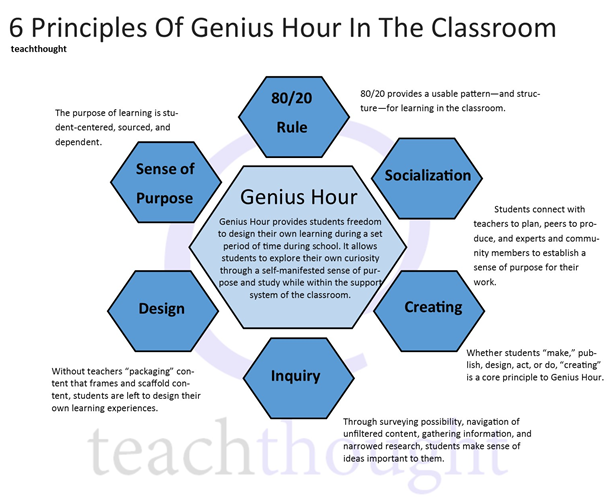In our previous post, we got to know about Genius Hour, in this post after briefly discussing why GH we shall discuss the 6 principles of GH.
Why students need Genius Hour?
In essence, high school students have spent most of their academic lives being told what to do. Their grades are then dependent on how well they completed the assigned tasks. Most teenagers spend their free time doing things they are “not told to do”. For example, most parents aren’t yelling at their son to play video games, or at their daughter to spend three hours on Facebook. These actions are done because teenagers want to do them (and in part because they are told many times not to do this). My class agreed that most teenagers “want to do what they want to do, and not what others tell them”.
Imagine one project that will teach:
- Goal Setting
- Implementing Goals
- Reflecting and Redirecting Goals
- Showcasing Goals
Genius Hour can do all of the above. By allowing students to choose any goal, accomplishment, project of their choice, and then guide the students through the process, we can give them the foundation of successful autonomous learning.
I found this interesting post on 6 principles of GH by Terry Heick on teachthought.com; thought to share it with you guys…enjoy the post!

- Sense of Purpose
Students must find their own sense of purpose in what they study, make sense of, and create. The context and motivation are no longer entirely academic, which forces both the student and teachers to make adjustments.
- Design
Without teachers “packaging” content that frames and scaffold content, students are left to design their own learning experiences.
- Inquiry & Navigation
Through surveying possibility, navigation of unfiltered content, gathering information, and narrowed research, students make sense of ideas important to them. This navigation and survey of possibility then leads to more narrow inquiry and research. In this way, inquiry-based learning has significant overlap with Genius Hour.
- Create
Whether students “make,” publish, design, act, or do, “creating” is core to Genius Hour. There is always a visible product or function of the learning.
- Socialization
Students connect with teachers to plan, peers to produce, and experts and community members to establish a sense of purpose for their work.
- 80/20 Rule
The 80/20 rule is important, as it provides the only structure of most Genius Hour learning. Whether it’s an “hour,” one day per week, or something else, it provides a kind of schedule while contrasting usefully with traditional academic “training.”
About the author:
Sahil Sayed is an Educator, Teacher, and Learner. An engineer who understood science and mathematics little better after teaching primary grades for almost 4 years now. Currently heading Science, Mathematics and ICT department at Red Camel International School, India.
Leave a Reply